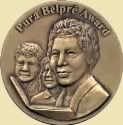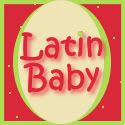Ms. Delacre’s commitment to sharing Latino heritage through her work comes from a conviction that Latino children need to learn and share their cultural roots to make connections that blossom into acceptance.
Born the middle daughter to two university professors in Puerto Rico, Lulu’s love of drawing was fostered at a very early age by her abuelita, who kept a constant supply of drawing paper on hand. Her formal art education began years later in Argentina, when Lulu took a painting class taught by a friend of her mother. She eventually went on to study in L’Ecole Supérieure d’Arts Graphiques in Paris, France, where she found her passion in illustrating children’s books.
The LBBC has reviewed several of Lulu’s books including, Los Zapaticos de Rosa, The Bossy Gallito, Señor Cat’s Romance, The Storyteller’s Candle and this month’s Libro del Mes: Arroz con Leche: Popular Songs and Rhymes from Latin America. Her books have received numerous awards including the Pura Belpré Honor Award, the Américas Honor Award, and an ALA Notable to name a few.
Lulu’s most recent release, Alicia Afterimage, is an emotional yet powerful account of teenage and maternal grief based on the passing of one of her own teen-age daughters. A series of interviews with close teen-age friends help the reader to understand the forms and stages of grief, as well as present the process of healing. For more information about Alicia Afterimage, visit Lulu’s web site here.
Readers will find a great diversity in her books, both in illustration techniques and written content. Fortunately, for us, Ms. Delacre graciously agreed to answer a few questions for the LBBC so that you, our readers, could learn a bit more about her…
Q: You’ve stated that the idea to become a children’s book illustrator came as an epiphany at an art gallery where you found the complete illustrations of Maurice Sendak’s In the Night Kitchen. Why and how did you start writing them as well? Has it been difficult to do so, since English is not your first language?
A: In 1984, I accompanied my husband to Maine for three months while he was taking some courses. There, I found myself sketching children's book characters from my imagination. Later, on a trip to New York I visited many publishing houses and showed the sketches of the little elephant I had created. Editors and art directors alike told me to write a story for this character. Even though I did not consider myself a writer and I saw the task as a daunting one since my mother language was Spanish, I set myself to it. After many tries and false starts, I discovered that writing can be learned if you are creative and apply yourself. Twenty-six years later I still work very hard at improving the craft of writing.
Q: You’ve said that you believe Latino children growing up here in America need to be exposed to the heritage of their parents. How do you think this knowledge strengthens us as adults? In what way does learning about our parent affect the way we live as Americans?
A: Knowing where you come from gives you the strength and confidence to choose what path to follow in life. Latino children who grow up in the United States are enriched by learning about their parents’ heritage and language. They will grow up to have broader horizons and be more tolerant of others. This will foster respect for the ways of their ancestors, respect for others, and may even make them curious about different cultures and peoples.
 Q: Like many illustrators, you add personal touches – like recipes, or particular settings - to the books that you’ve written and illustrated. But you also go to great lengths to supplement the story with real details, as in The Storyteller’s Candle. The books that you’ve either illustrated or written are not simple stories for children, but rather they are tools for teaching lessons. Why is this so important to you?
Q: Like many illustrators, you add personal touches – like recipes, or particular settings - to the books that you’ve written and illustrated. But you also go to great lengths to supplement the story with real details, as in The Storyteller’s Candle. The books that you’ve either illustrated or written are not simple stories for children, but rather they are tools for teaching lessons. Why is this so important to you?A: Perhaps being the daughter of two university professors had something to do with the way I illustrate. Perhaps the fact that I love to do research makes a bit of this research seep into my work. The truth is that I don't intentionally set out to teach anything when I write or illustrate a story. However, when I am done I often find that there are subtle lessons embedded in my work that often can be expanded in the back matter of the book.
Q: Your books reflect very different artistic styles or techniques. What determines the manner in which you illustrate a particular story?
A: The manuscript, always the manuscript. I read and reread a manuscript until I visualize the style that will best complement and expand the text. I also love a challenge and do not shy away from experimenting with new techniques.
Q: Do you have any new books coming out soon that we can look forward to reading?
A: I am currently working on a series of interactive books to help the autistic and special education child learn the English language. Of course, this has provided me with yet another opportunity to illustrate in an entirely different way! Look for the JAY AND BEN books in 2011.
To learn more about Ms. Delacre’s work, or to read about the many presentations she offers to both children and adults, visit her web site, http://www.luludelacre.com/
To read more interviews with Ms. Delacre, visit Colorin Colorado’s Meet the Author page here.





















0 comments:
Post a Comment